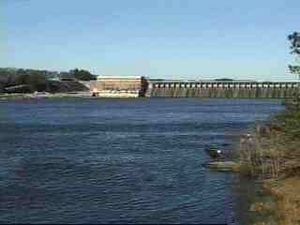Lay Dam facts for kids
Lay Dam is a big dam on the Coosa River in Chilton County and Coosa County, near Clanton, Alabama. It helps make electricity for people's homes and businesses. It's also next to a popular lake called Lay Lake, where many families go to fish and have fun.
Lay Dam: Making Clean Energy
Lay Dam is a special kind of dam called a hydroelectric power dam. This means it uses the power of flowing water to create electricity. It was built a long time ago, in 1914. It was the very first big project for a company called Alabama Power Company. The dam was named after Captain William Patrick Lay, who was the first president of that company.
The dam itself is made of concrete and is known as a "run-of-the-river gravity dam." This means it uses its own weight to hold back the water, and it lets water flow over or through it constantly. The power plant at Lay Dam can make a lot of electricity, about 177 megawatts (MW). That's enough power for many thousands of homes!
Before the dam was built, the area where it stands was once home to Fort Williams. This fort was important during a historical event called the Creek War. When the dam was constructed and the lake filled up, the original site of the fort became covered by water.
Exploring Lay Lake
Right next to Lay Dam is a large and beautiful lake called Lay Lake. This lake covers a huge area, about 12,000 acres. Its shoreline, which is the edge of the lake, stretches for about 289 miles. That's a very long way!
Lay Lake is a favorite spot for many outdoor activities. It's especially popular for fishing. People can catch all sorts of fish here, including large mouth bass, spotted bass, and different types of sunfish like bluegill. You might also find crappie, catfish, striped bass, and hybrid or white bass.
The lake is so well-known for its fishing that it has hosted a very famous fishing competition called the Bassmaster Classic four times. These big events happened in 1996, 2002, 2007, and 2010. To make it easy for everyone to enjoy the lake, Alabama Power has created seven public places where people can get to the water.


